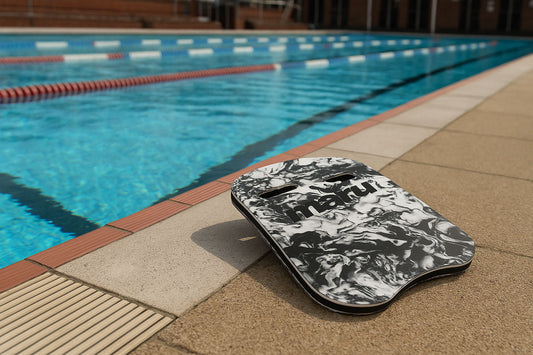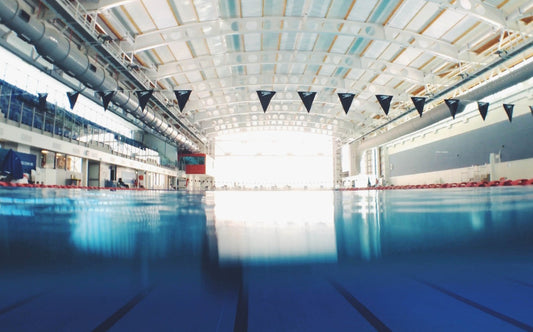Swimming Advice

Hand Paddles: The Game-Changing Tool for Develo...
As a swim coach who has worked with hundreds of young swimmers throughout the UK, I can confidently say that hand paddles are one of the most transformative training tools available. While they might appear simple – essentially flat surfaces that attach to your hands – these training aids can dramatically improve technique, build strength, and accelerate swimming development when used correctly. Hand Paddles: Understanding the Purpose Hand paddles work by increasing the surface area of your hands, creating more resistance through the water. This resistance forces swimmers to engage their larger muscle groups more effectively and develops a stronger, more efficient pull. For young swimmers, this translates to better technique awareness and significant strength gains that carry over into their regular swimming. The increased resistance also heightens sensory feedback, helping swimmers feel the water more effectively. This enhanced "feel for the water" is crucial for developing the subtle hand and forearm movements that separate good swimmers from great ones. Help Stroke Development and Technique With Hand Paddles Hand paddles excel at teaching proper catch and pull mechanics. When young swimmers use paddles, they immediately notice if their hand entry is sloppy or if they're pushing water backwards instead of gripping it effectively. The paddles essentially amplify technique flaws, making them impossible to ignore. Freestyle: Paddles help swimmers develop the high elbow catch position essential for efficient freestyle. The increased surface area makes it easier to feel when the hand and forearm are working together as one unit to grip the water. Backstroke: The resistance provided by paddles helps backstrokers develop the proper S-shaped pull pattern whilst building the shoulder and lat strength necessary for powerful backstroke swimming. Butterfly: Though challenging, paddles can help butterfly swimmers develop the simultaneous pull pattern and build the significant upper body strength this stroke demands. Building Swimming-Specific Strength The resistance training aspect of hand paddles cannot be overstated. Regular paddle use develops the specific muscle groups used in swimming – the lats, shoulders, forearms, and core, in the exact movement patterns required for efficient swimming. This strength development is particularly valuable for young swimmers who may not yet have access to or be ready for traditional dryland training. Paddles provide a safe, swimming-specific way to build the strength necessary for competitive swimming whilst remaining in the pool environment. The progressive overload principle applies perfectly to paddle training. As swimmers become stronger and more technically proficient, they can use larger paddles or incorporate more challenging training sets. Developing Water Feel and Timing One of the most significant benefits of paddle training is the development of water feel – the ability to sense how your hands and arms are moving through the water. The increased surface area and resistance help swimmers understand the difference between effective and ineffective movements. Young swimmers often struggle with timing and rhythm, particularly in strokes like butterfly and breaststroke. Hand paddles help establish proper timing by making it easier to feel when the pull is most effective and when the hands should exit the water. Injury Prevention Through Proper Technique When used appropriately, hand paddles can actually help prevent common swimming injuries. By forcing swimmers to engage their larger muscle groups and maintain proper technique, paddles reduce the likelihood of shoulder impingement and other overuse injuries common in competitive swimming. The key is proper progression and supervision. Young swimmers should start with smaller paddles and gradually work up to larger sizes as their technique and strength improve. This gradual progression ensures that good habits are established before challenging the system with increased resistance. Confidence Building in Training There's something particularly satisfying about the power and speed that hand paddles can provide. Young swimmers often experience an immediate boost in confidence when they feel themselves moving through the water more powerfully. This positive feedback can be incredibly motivating and help maintain enthusiasm for training. The speed increase that comes with proper paddle use also helps swimmers understand what efficient technique feels like. They begin to associate good technique with increased speed, creating a positive feedback loop that encourages continued improvement. Choosing the Right Hand Paddles Selecting appropriate hand paddles is crucial for maximising benefits whilst minimising injury risk. For young swimmers, smaller paddles are generally better. The paddle should extend slightly beyond the hand in all directions but shouldn't be so large that it compromises technique. Look for paddles with straps that provide a secure but comfortable fit. The material should be durable enough to withstand regular use whilst being smooth enough to prevent chafing. Quality paddles, like Maru, will maintain their shape and effectiveness over time, making them a worthwhile investment. Maru paddles feature holes or vents that reduce resistance slightly whilst still providing technique benefits. These can be excellent for younger swimmers or those new to paddle training. Training Applications and Progressions Hand paddles can be incorporated into virtually any training set, from warm-up exercises to high-intensity intervals. For young swimmers, I recommend starting with short distances and focusing on maintaining proper technique rather than swimming as fast as possible. Common progressions include alternating lengths with and without paddles, which helps swimmers feel the difference in resistance and technique. This contrast training is particularly effective for developing awareness of proper mechanics. Safety Considerations While hand paddles offer numerous benefits, they must be used responsibly. Young swimmers should never use paddles for extended periods without breaks, as the increased resistance can lead to fatigue and technique breakdown. Proper supervision and progression are essential. Swimmers should also be taught to remove paddles immediately if they experience any shoulder discomfort. Building strength and technique takes time, and rushing the process can lead to injury. The Long-Term Investment Quality hand paddles represent an excellent investment in your young swimmer's development. The technique improvements, strength gains, and confidence building that result from proper paddle training will benefit them throughout their swimming career. The enhanced water feel and stroke mechanics developed through paddle training become permanent improvements that carry over into all swimming activities. Whether your child swims competitively or recreationally, the benefits of proper paddle training will serve them well. Hand paddles are more than just training equipment – they're tools for transformation. When used correctly under proper supervision, they can accelerate technique development, build swimming-specific strength, and create the kind of positive training experiences that keep young swimmers motivated and engaged. Every efficient stroke begins with proper hand position and water feel. Give your young swimmer the tools they need to develop these crucial skills with quality hand paddles that will support their growth from novice to accomplished swimmer.
Hand Paddles: The Game-Changing Tool for Developing Young Swimmers
As a swim coach who has worked with hundreds of young swimmers throughout the UK, I can confidently say that hand paddles are one of the most transformative training tools...

The Power of the Kickboard: Why This Simple Too...
As a swim coach working with young athletes across the UK, I've seen countless swimmers transform their technique and build confidence with one simple piece of equipment: the kickboard. While it might look like just a floating board, the humble kickboard is actually one of the most valuable training tools in any swimmer's arsenal. Are Kickboards Good for Kids? The kickboard allows young swimmers to isolate and focus purely on their kick technique without worrying about arm movements, breathing, or body position. This isolation is crucial for developing proper leg strength and rhythm. When children can concentrate solely on their kick, they develop muscle memory much faster and build the foundational strength needed for all swimming strokes. Yes, kickboards are a fantastic training tool for young swimmers whether they're just starting out or competing. Best Kickboards for Swimming? For parents watching their children in lessons, you'll notice how much more confident young swimmers become when they can hold onto something stable. The best kickboards, like Maru, provide that security whilst still allowing them to work on essential skills. It's particularly beneficial for nervous swimmers who might struggle with body position or breathing initially. What are the Stroke-Specific Benefits of Using a Kickboard? Each swimming stroke relies heavily on an effective kick, and the kickboard helps develop these specific movement patterns: Kickboard benefits for Freestyle and Backstroke: The flutter kick becomes more powerful and efficient when practiced with a kickboard. Children learn to keep their legs straight, maintain proper ankle flexibility, and develop the quick, alternating rhythm essential for speed. Kickboard benefits for Breaststroke: The kickboard allows swimmers to perfect the complex frog kick motion, focusing on the precise timing of the knees drawing up, feet flexing, and the powerful push-off that propels them forward. Kickboard benefits for Butterfly: Though challenging, practicing dolphin kick with a kickboard helps young swimmers develop the undulating body motion and core strength necessary for this demanding stroke. Build Physical Development and Conditioning With Your Kickboard Regular kickboard training provides excellent cardiovascular conditioning whilst building specific swimming muscles. The quadriceps, hamstrings, glutes, and core all work together during kick sets, creating a comprehensive lower body workout that directly translates to improved swimming performance. The resistance of the water against the legs during kickboard exercises also helps develop the fast-twitch muscle fibres essential for sprint swimming, whilst longer kick sets build the endurance needed for distance events. How Can Kickboards Help With Technique Refinement? Beyond basic skill development, kickboards are invaluable for refining technique. Coaches can easily spot and correct common faults such as scissor kicks, bent knees, or poor ankle position when swimmers are using a kickboard. This immediate feedback helps establish proper movement patterns from an early age. The kickboard also helps swimmers develop a feel for the water and understand how their kick affects their body position and speed. This proprioceptive awareness is crucial for becoming an efficient swimmer. How Do Kickboards Help Build Swimming Confidence and Independence? For young swimmers, the kickboard represents independence in the water. It allows them to travel distances they couldn't manage otherwise, building confidence and endurance gradually. Many children who initially cling to the pool edge will happily push off and kick across the pool when given a kickboard. This confidence boost is particularly important for competitive swimmers. When young athletes can maintain their kick technique even when tired, they're more likely to finish races strong and maintain good form throughout longer training sessions. How to Choose the Right Kickboard? Not all kickboards are created equal, and selecting the right one can make a significant difference to your child's training experience. Look for boards that are appropriately sized for your child's age and strength level. Younger swimmers need smaller, more manageable boards, whilst older children can handle larger boards that provide more buoyancy and stability. Quality matters too. A well-made kickboard should be durable enough to withstand regular use, comfortable to grip, and provide consistent buoyancy. The material should be chlorine-resistant and easy to clean, as kickboards see heavy use in pool environments. How Coaches Making Training Engaging Using Kickboards Kickboard training doesn't have to be monotonous. Creative coaches use kickboards for relay races, target practice, and technique games that keep young swimmers engaged whilst developing their skills. The versatility of the kickboard means it can be incorporated into warm-ups, main sets, and even recovery sessions. Swim Kickboards are a Long-Term Investment Investing in a quality kickboard is investing in your child's swimming future. The strength, technique, and confidence developed through regular kickboard use will benefit them throughout their swimming journey, whether they're swimming for fitness, competition, or pure enjoyment. The kickboard truly is an essential tool for any young swimmer's development. It builds strength, refines technique, boosts confidence, and provides the foundation for a lifetime of swimming success. When choosing equipment for your child's swimming journey, a quality kickboard should be at the top of your list. Every stroke begins with a strong kick, and every strong kick begins with proper training. Give your young swimmer the tools they need to succeed -> starting with a reliable kickboard that will support their development stroke by stroke, length by length.Shop the Maru Kickboards in 5 different colour styles
The Power of the Kickboard: Why This Simple Tool is Essential for Young Swimmers
As a swim coach working with young athletes across the UK, I've seen countless swimmers transform their technique and build confidence with one simple piece of equipment: the kickboard. While...

Five ways to help you wake up for early trainin...
There’s no denying it: we all love to sleep. But there’s also a lot to be said for waking up early and getting your day started before everyone else.
Five ways to help you wake up for early training sessions
There’s no denying it: we all love to sleep. But there’s also a lot to be said for waking up early and getting your day started before everyone else.

Swim Strengthening Tips: are all pull buoys the...
No, not all pull buoys are the same. Pull buoys, used in swimming to support a swimmer’s legs and help with upper body training, vary in several ways. Read more
Swim Strengthening Tips: are all pull buoys the same?
No, not all pull buoys are the same. Pull buoys, used in swimming to support a swimmer’s legs and help with upper body training, vary in several ways. Read more

Swim Strengthening Tips: What are the key benef...
Swimming is a sport that requires a blend of strength, endurance, technique, and balance. For swimmers looking to hone their skills, a simple tool like the pull buoy can be a game-changer.
Swim Strengthening Tips: What are the key benefits of using a pull buoy?
Swimming is a sport that requires a blend of strength, endurance, technique, and balance. For swimmers looking to hone their skills, a simple tool like the pull buoy can be...

Going the distance: should you be a sprint or d...
Deciding between sprint and distance swimming is key to maximising your strengths in the pool—find out which style suits you best.
Going the distance: should you be a sprint or distance swimmer?
Deciding between sprint and distance swimming is key to maximising your strengths in the pool—find out which style suits you best.
